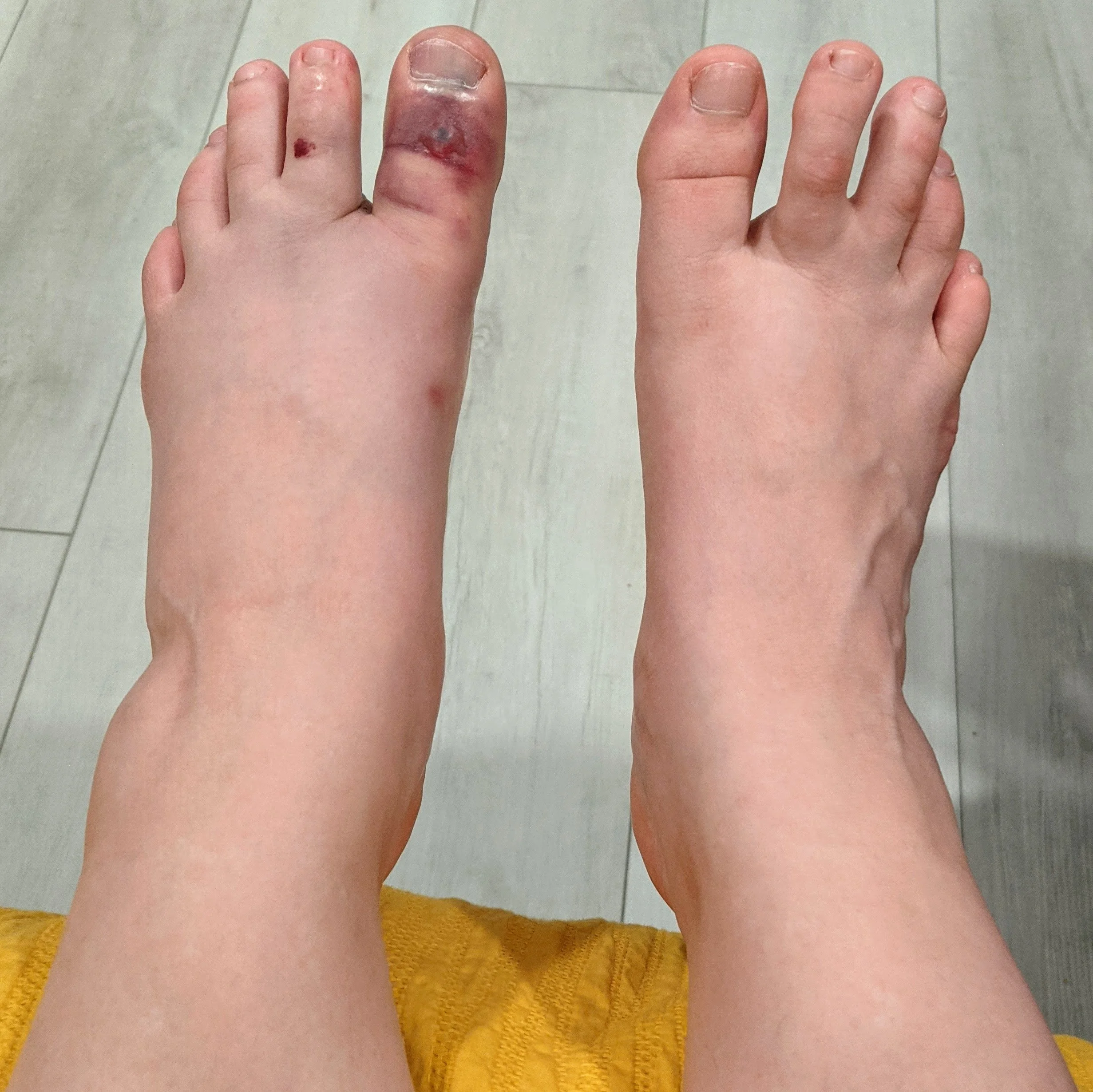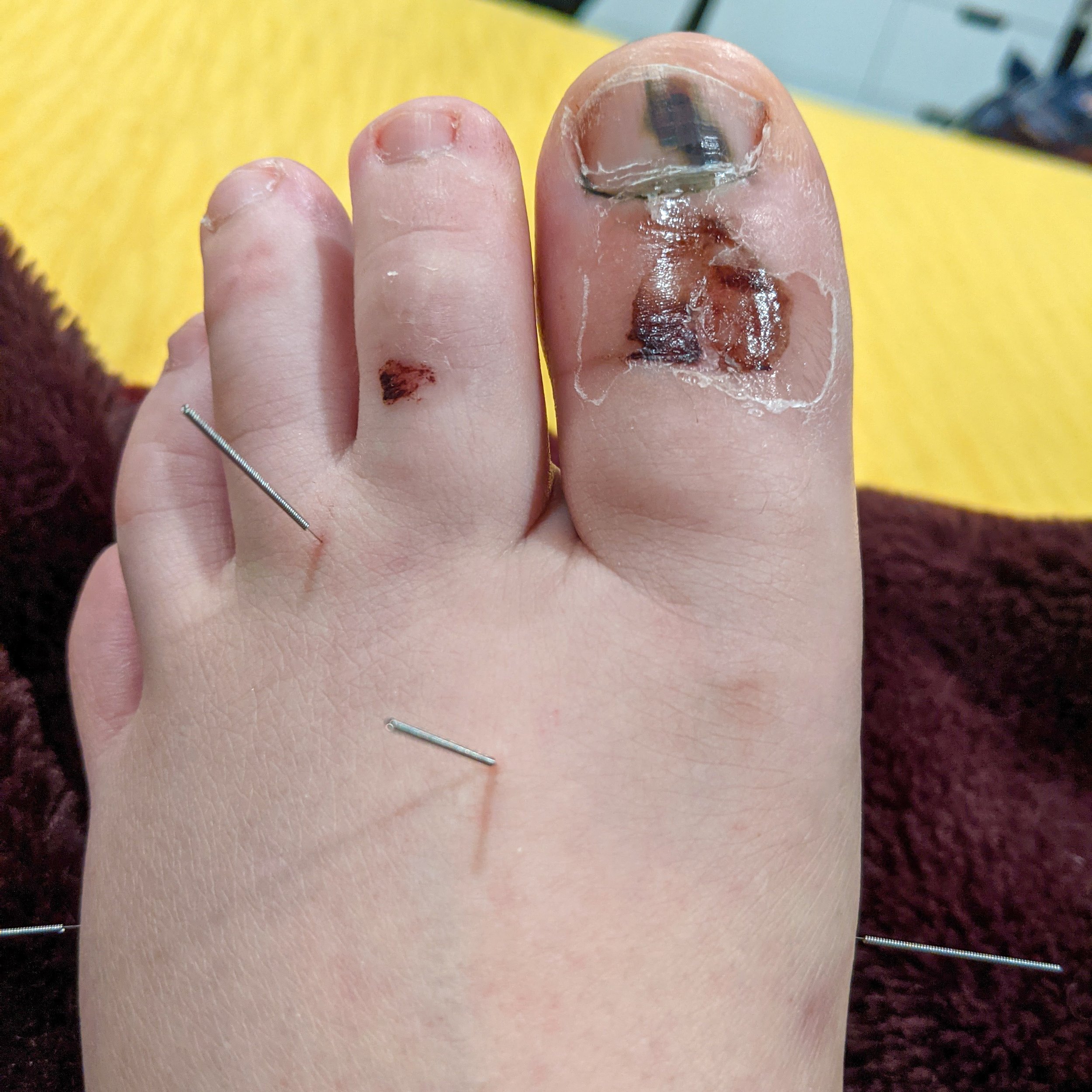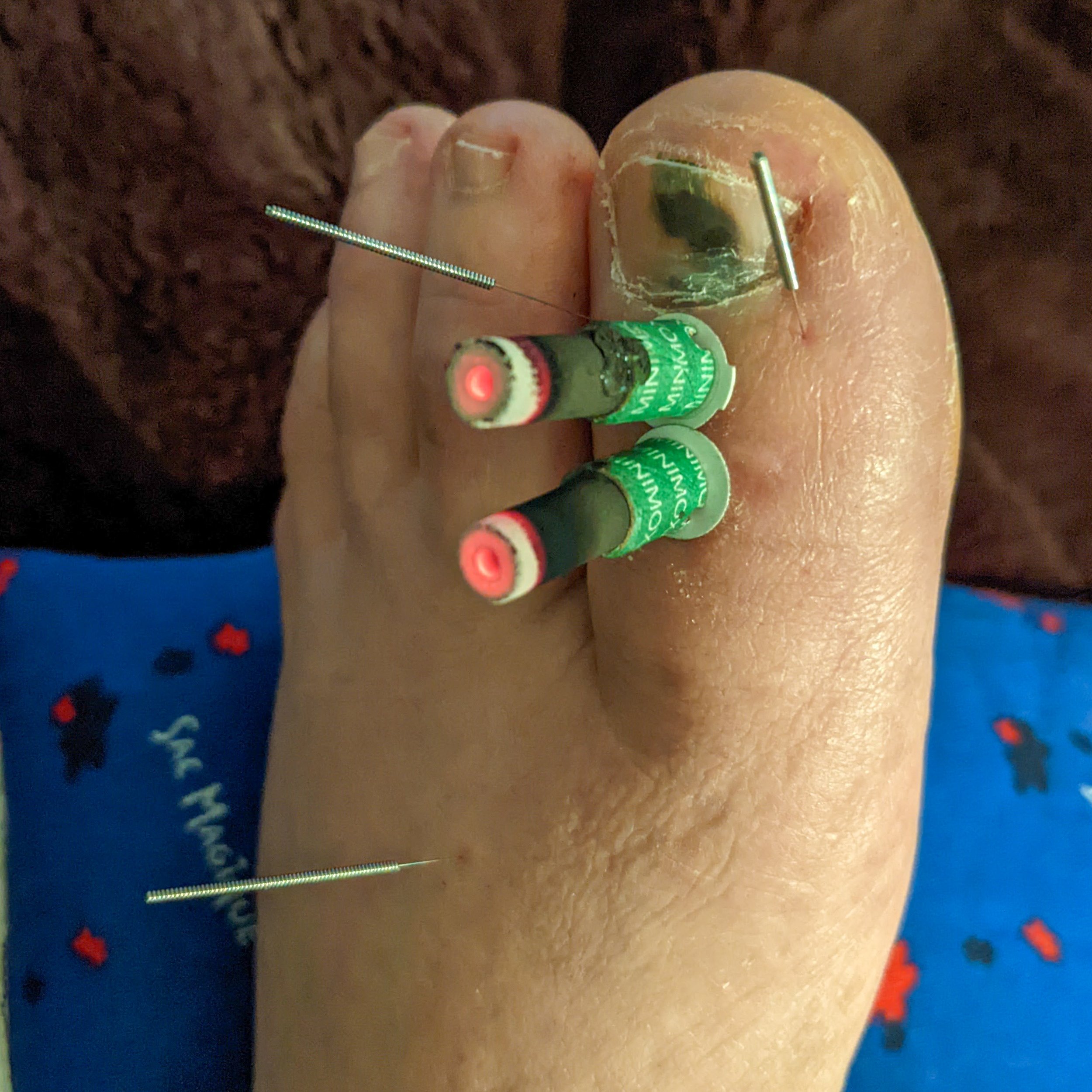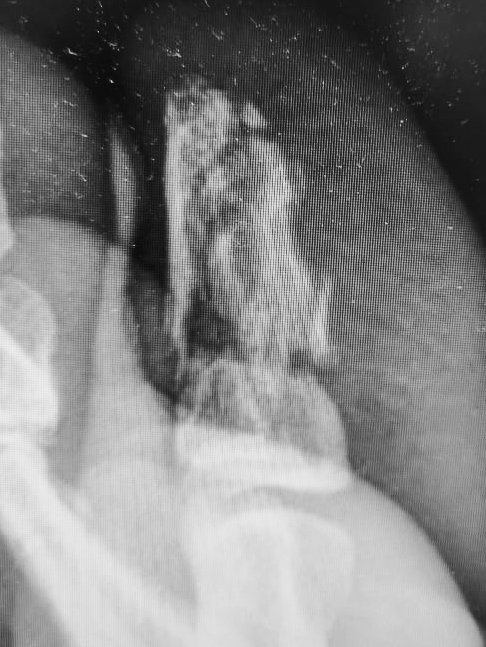Traditional Chinese Medicine Case Report: Broken Big Toe
I broke/crushed my left big toe last November. Laying in the hospital ER waiting for the anti-inflammatory injection to kick in, I did the obvious and started checking my herb suppliers for available herbal formulas and double checked a few TCM reference books for fracture treatment protocols - yes, I have them on my phone for easy access. It was also partly to keep myself distracted from the pain. Even breaking such a small bone was completely excruciating; once the injection I got from the hospital wore off later that night I actually woke up gasping and tearful. So, while I love what acupuncture and TCM can do to heal the body and have written this case study to help highlight that, I never underestimate the necessity of painkillers during acute care.
Anyway, breaking a toe sucks but I was excited to use myself as a case study for mid-late stage fracture recovery because I don’t often see recently broken bones in my clinic. I’ve written this under the assumption that if you are reading it, you are an Acupuncturist, a TCM Doctor/Practitioner of some variety, or a student of TCM. If you’re not, this will read a bit jargon-heavy but you are absolutely still welcome to come along for the ride. Unless you don’t like feet - in that case you might want to sit this one out.
Content warning: There are close up pictures of my injured toe, x-rays, and acupuncture treatments throughout this article.
The Intake
Chief Complaint: Broken left big toe (hallux bone), crushed by dropping a 25lb metal plate weight on it
Western Diagnosis: Comminuted fracture of 1st distal phalanx; Primary care doctor consulted with orthopedic surgeon, determined surgery not required/possible (too many small bone pieces)
Other Details: X-rays taken to confirm damage, no other bones involved; told to immobilize and rest until appointment with orthopedic surgeon (2 weeks post-injury), prescribed Naproxen (anti-inflammatory) for pain
Assessment of the injured area (12 days post-injury):
Constant swelling of the injured toe
Minimal to no pain at rest (pain killers no longer required), very sensitive to touch; occasional achy pain with activity, 2/10 severity
Numbness/tingling of the injured area with touch
Swelling on and off in the whole food with activity (moving around with walking boot and crutches)
Bruising on top and underneath the 1st MTP joint, under the nail; fluid blister on top of toe that required draining twice
Tight sensations in the tendon of flexor digitorum longus, sensation travelled up into calf
Calf pain (possibly from walking boot), calf muscle tone is decreased
Body temperature, skin, sweating: Recent acne flare up (last 3 months), cheeks and chin, raised bumps, mild redness, began with high stress
Head, eyes, ears, nose, mouth: No symptoms to note
Chest: No symptoms to note
Abdomen: Decreased appetite, sometimes none, craving sweet and salty foods towards the evening
Bowel movements, urination: No changes from normal, tend towards loose/very loose BM usually
Sleep: +1 year irregular sleep schedule, staying up late, need 8-10 hours of sleep required to feel rested, difficulty falling asleep (no difficulty staying asleep), use cannabis (indica) edibles to help occasionally, liquid melatonin has also worked in the past
Energy: Low, especially mental/emotional energy, easily tired
Menstruation: Currently on day 24/31 of estimated cycle, 4.5 days average flow, 1-2 days heavy, fresh red colour, medium sized red clots on heavy days, PMS = very strong fatigue on first or second day for about 6 hours, no cramps (I treated myself for those in the past!)
Tongue: Swollen with TM on the sides and towards the front, pale red body, thick dirty coating towards the back
Pulse: Ride side - moderate cun/chi, slightly weaker and slippery guan; Left side - weak, somewhat wiry
My big toe 2 days after I broke it. Very swollen, very sensitive, with a nice big blister starting to form over the injury site.
TCM Diagnosis
Constitution: Spleen Qi Deficiency with Lower Jiao Dampness
Injury: Fracture - Qi and Blood Stagnation with Local Fluid Stagnation
Treatment Principles: move qi, activate blood, reduce swelling, alleviate pain, benefit bone, strengthen Spleen
Treatment
HERBAL MEDICINE
I selected two different TCM herbal formulas for mid to late stage fracture recovery since I knew they wouldn’t arrive for about 2 weeks; I’m still working on increasing the herb stock at my clinic and didn’t have herbal medicines for the acute stage (first 48-72 hours).
The first herbal formula I chose - called Osteo8 - was for strengthening the bones, primarily by replenishing Kidney jing (essence). This makes it great for bone fracture recovery as well as for protecting against long-term degenerative conditions like osteoporosis. In Western Medicine terms many of the herbs in this formula have osteogenic and osteoprotective effects that help increase bone mass and density. Others are angiogenic (encourage blood vessel formation) and help with wound healing and tissue regeneration.
The herbs in this formula are:
Lu Jiao (Cornu Cervi) - yang tonic, replenishes Kidney jing (essence), nourishes blood and strengthens sinews and bones
Gu Sui Bu (Rhizoma Drynariae), Xu Duan (Radix Dipsaci) - yang tonics, these are a good pair of herbs for bone fractures or bad sprains to promote mending of bones and to relieve soreness, weakness, and pain
Gui Ban (Plastrum Testudinis), Gou Qi Zi (Fructus Lycii), E Jiao (Colla Corii Asini) - yin and blood tonics, all go to the Liver and Kidneys to nourish essence and support bone and tissue healing
Dang Gui (Radix Angelicae Sinensis), Ren Shen (Radix et Rhizoma Ginseng) - blood and qi tonics respectively, added to provide overall strengthening for the body during recovery
The second formula I chose - Flex MLT - was more focused on supporting the recovery of soft tissues and benefiting the joints. It can be used for soft tissue injuries or for help protecting the joints/cartilage against wear and tear from repetitive movements. It is meant for the mid-to-late stages of an injury since some of the herbs can be counterproductive if there is still severe acute pain and inflammation. The herbs in this formula have chondroprotective (delays joint space narrowing), and osteogenic (promotes bone formation) properties. Some of the herbs also have neuroregenerative (stimulates growth/repair of nerve tissues), analgesic (pain-relieving), and anti-inflammatory properties.
The herbs in this formula are:
Dang Shen (Radix Codonopsis) - qi tonic (SP/LU) that also nourishes the blood
Dang Gui (Radix Angelicae Sinensis), Shu Di Huang (Radix Rehmanniae), Bai Shao (Radix Paeoniae Alba) - all blood tonics with the ability to nourish yin/preserve yin, this helps to promote blood circulation and the generation of new tissue; Dang gui and bai shao are a classic pair of herbs used to tonify blood in many different conditions
Chuan Niu Xi (Radix Cyathulae) - blood moving, goes to the Liver and Kidneys to strengthen sinews/bones and pairs with dang gui to invigorate blood which is good for traumatic pain and healing soft tissue
Wu Jia Pi (Cortex Acanthopanacis), Qian Nian Jian (Rhizoma Homalomenae), Xu Duan (Radix Dipsaci) - the first two dispel wind-damp and xu duan is a yang tonic; All three go to the Kidneys and Liver to strengthen the sinews and bones, good for stiffness and weakness
Chu Shi Zi (Fructus Broussonetiae), Zhi He Shou Wu (Radix Polygoni Multiflori Praeparata) - yin tonics that nourish the Liver and Kidneys and will strengthen muscles, tendons, cartilage, and ligaments
Between these two formulas there are many herbs that enter the Liver and the Kidneys. The Liver is responsible for the free flow of qi and controls the sinews - ie. tendons, ligaments, fascia - making it a key organ to address in soft tissue injury. The Kidneys store essence, produce marrow and control the bones. When essence is strong, our bones are healthy and can heal more quickly. This makes the Kidneys the most important organ for many bone-related issues, including fractures. There are also some Spleen/qi tonics since the Spleen will provide the post-natal qi to support injury healing, and it controls the muscles - although the muscles aren’t as much of a concern in this specific case.
For the sake of ease I opted for both formulas in pill form, ordering enough for about 4 weeks (3 pills of each, 3x/day). This meant I would finish both formulas about 6 weeks after my injury and would hopefully be ready to start doing movement rehabilitation exercises.
[ If you are not familiar with TCM herbal medicines, a caution: TCM herbs should always be prescribed by a trained practitioner after a full assessment. Herbs have multiple functions and just because one function may help you does not mean that herb is good for your body as a whole. Herbs are also more powerful in formulas; the combination of herbs and their synergistic effects are what provides maximum benefit for the body. ]
ACUPUNCTURE
The acupuncture treatment for my broken toe was pretty straightforward. I waited until 2 weeks after my injury to start needling because 1. Even though I’m comfortable needling myself, it can be hard to muster the energy to do it right after an injury and 2. I wanted to see the orthopedic surgeon to see what they thought. In hindsight, I could’ve probably started after 1 week.
The main acupuncture treatment goals for broken bones are to relieve swelling, move/activate blood, eliminate pain, and promote the regeneration of bone and soft tissues. The points I picked are mainly on the legs since I find that easier to do on myself at home.
The points I used initially were:
LR-3 - Shu-Stream, Yuan-Source, Earth - Spreads Liver qi, nourishes Liver blood and yin, a point local to the injury to move qi and blood. I experimented with LR-3/LR-2 and sometimes needled towards the big toe instead of the usual perpendicular insertion.
GB-34 - He-Sea, Earth, Influential of Sinews - An essential point for many injuries, aches, and pains. Benefits the sinews and joints, activates the channel and alleviates pain.
SP-5 - Jing-River, Metal - Fortifies the Spleen and resolves dampness, benefits the sinews and bones. Since I’m not able to needle UB-11(the influential point of bone) on myself SP-5 combined with GB-39 are the next best option for healing bone fractures.
GB-39 - Influential of Marrow - Another essential for broken bones. Benefits the sinews and bones, dispels wind-damp, activates the channel and alleviates pain.
SP-9 - He-Sea, Water - Regulates the Spleen and resolves dampness, opens and moves the water passages. This point is good for swelling (edema) and pain in the lower limbs. I combined it with ST-40 because my constitution tends towards lower jiao dampness, especially during periods of time when I’m more sedentary.
ST-36 - He-Sea, Earth - Tonifies qi and nourishes blood and yin, activates the channel and alleviates pain. More for my body/constitution as a whole, but it never hurts to use this point for injury healing.
ST-40 - Luo-Connecting -Transforms phlegm and dampness, activates the channel and alleviates pain. A point for my constitution and to help reduce swelling in my foot.
LI-4 - Yuan-Source - This point has many applications, here I’m using it to move qi and blood through all the channels in combination with LR-3. Needled only on the left side as I wanted to keep my right hand free.
I didn’t use points directly over the fracture (on the big toe) right away as the area was still very sensitive; after a few treatments however, the sensitivity went down so I experimented with points like SP-1, SP-2, SP-3, LR-1, and ST-44 or points in other areas of my foot that felt tender or swollen on any given day. I also played around with using moxa in the area to improve blood circulation and because when I’m doing acupuncture at home my feet get cold very quickly.
I did treatments 1-3x/week for about 4 weeks, at which point I was cleared to begin moving my toe again by using the walking boot less or not at all. Anecdotally, about a week and a half before that I woke up with a distinct feeling that it was ready to move again - the sensitivity and guarding sensations I felt prior were gone, replaced with the feeling that it needed to be moved. Not one to rush, I did wait for my next set of x-rays to confirm what I felt before completely ditching the boot.
My first acupuncture treatment for my broken toe: This was about 2 weeks post-injury so I avoided getting too close to the sensitive area. The shiny film is liquid bandage over the large blister I had to drain the day before.
An acupuncture treatment I did very soon after getting home from clinic, with a little bit of moxibustion around ST-36 and the fracture site.
After the sensitivity in my toe decreased I started needling close to the fracture and sometimes used moxa cones to improve blood circulation in areas where I didn’t want to use needles.
Results
I don’t have other broken toe cases to compare mine to, so it is completely anecdotal when I say that I think the herbal medicine and acupuncture helped significantly in my recovery. After a few days taking Naproxen for pain initially, I haven’t taken any pain medication at all for this injury, and apart from a little soreness after beginning to wear/walk around in regular shoes again, I’ve had no pain, tingling, numbness, or shooting sensations in any part of my foot or leg.
The x-ray images I have are from about 12 hours after breaking my toe, then at the 2, 6, and 10 week marks. I won’t pretend that I know how to read an x-ray - that is absolutely outside the scope of TCM - but I do think it is very cool to be able to see some of the healing process and relate it to what I was feeling at the time.
Broken big toe - about 12 hours post-injury.
Broken big toe - 2 weeks post-injury
Broken big toe - 6 weeks post-injury
Broken big toe - 10 weeks post-injury
Six weeks post-injury the base of the bone was healed enough to start moving my toe around. I was told that the very the tip of the bone may take 1-2 more months to fully/solidly heal… since it was in so many pieces (see the pictures below). At this point I started gradual physical rehabilitation. For the most part this was simple weight bearing on my whole foot instead of just the heel, and gentle bending of my big toe.
Broken big toe about 12 hours after injury - side view
Broken big toe 10 weeks post-injury - side view
I had another x-ray at 10-weeks post-injury. The orthopedic surgeon told me that my toe was healing very well and that I could resume most of my regular activities. I still don’t have full flexibility back in the distal joint but as I continue strengthening exercises and acupuncture treatments over the next few weeks I don’t anticipate any issues resuming my usual powerlifting training again. Running will be another story as I am a forefoot striker, but we’ll cross that bridge when we get there.
In his book Sports Medicine Acupuncture, Matt Callison L.Ac recommends that athletes with significant injuries return to training by increasing activity by a maximum of 10% each week at most to prevent re-injury and to allow appropriate time for tissues to adapt to intense training again. I will follow that advice as I increase my walking distance gradually; by early spring I’d like to be back out hiking the Bruce Trail.
Thanks for reading! For more information about Traditional Chinese Medicine treatments
check out my other blog articles or my Instagram @alina.acupuncture.









